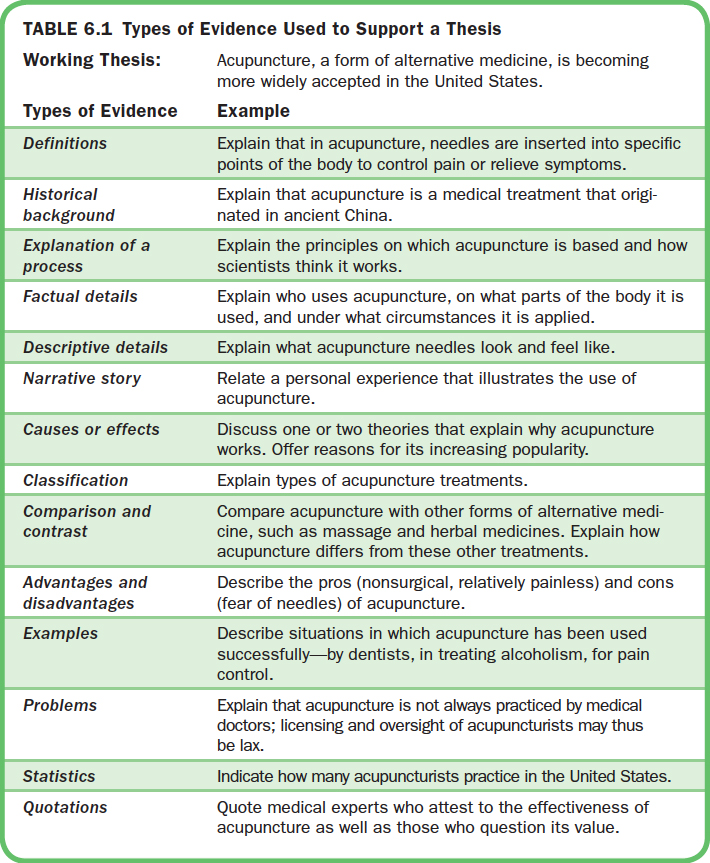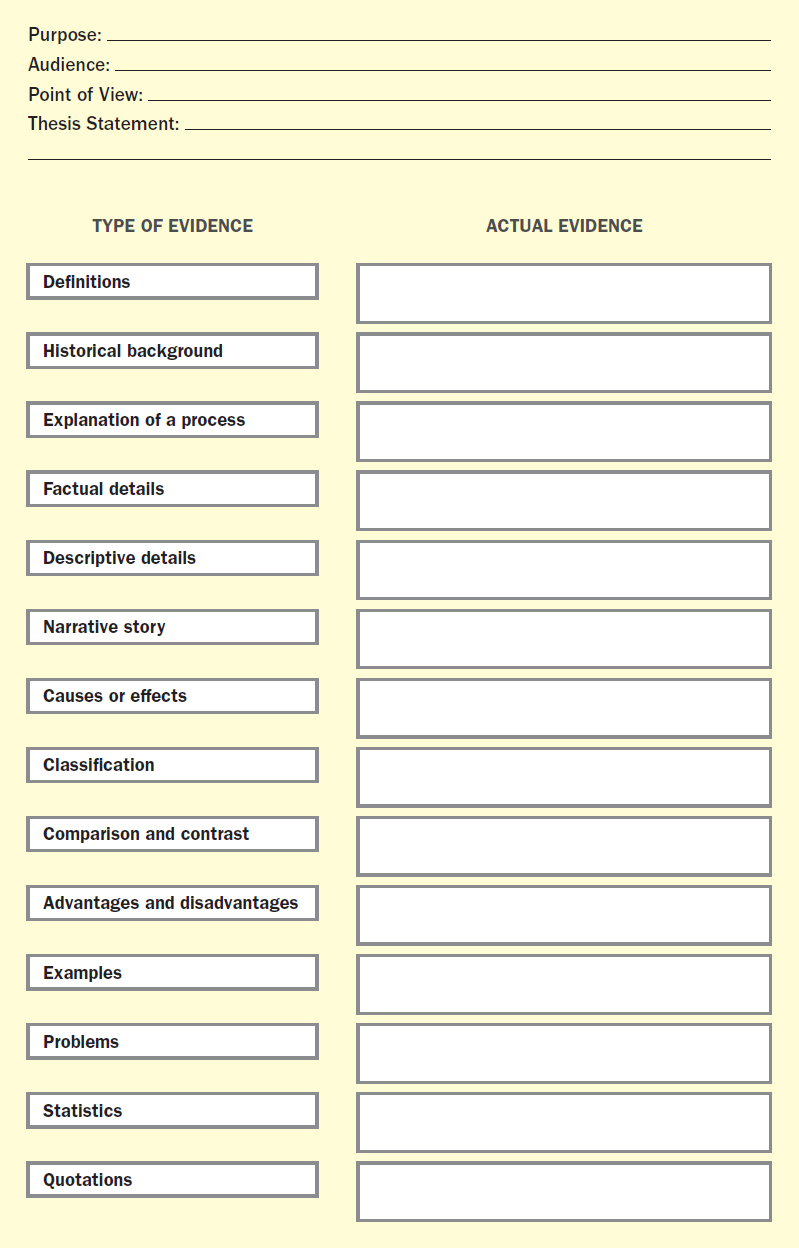SUPPORTING YOUR THESIS STATEMENT WITH EVIDENCE
After you have written a working thesis statement, the next step is to develop evidence that supports your thesis. Evidence is any type of information, such as examples and anecdotes, facts and statistics, or expert opinion, that will convince your reader that your thesis is reasonable or correct. This evidence, organized into well-developed paragraphs, makes up the body of your essay. To visualize the basic structure of an essay, look ahead to Figure 7.2.
TAILORING THE EVIDENCE TO YOUR WRITING SITUATION
Your writing situation — that is your purpose, audience, point of view, genre, and medium — will determine which types of evidence will be most effective. For example,
- if your purpose is to persuade, using comparison and contrast to highlight advantages and disadvantages, giving examples of problems, citing statistics to support your claim, and using quotations from experts may help make your argument convincing.
- if your audience is unfamiliar with your topic, providing definitions, historical background, an explanation of a process, and factual and descriptive details may be necessary.
Table 6.1 lists various types of evidence and gives examples of how each type could be used to support a working thesis on acupuncture. Note: Many of the types of evidence correspond to the patterns of development discussed in Chapters 12-21.

COLLECTING EVIDENCE TO SUPPORT YOUR THESIS
Depending on your learning style, select one or more of the following suggestions to generate evidence that supports your thesis.
Learning Style Options
- Complete the worksheet in Figure 6.2. For one or more types of evidence listed in the left column, provide examples that support your thesis in the right column. Collect evidence only for the types that are appropriate for your thesis.
- Picture yourself speaking to your audience. What would you say to convince your audience of your thesis? Jot down ideas as they come to you.
- Develop a skeletal outline of major headings. Leave plenty of blank space under each heading, and fill in ideas about each heading as they come to you. (For more on outlining, see Chapter 7.)
- Draw a graphic organizer of your essay, filling in supporting evidence as you think of it. (For more on drawing a graphic organizer, see Chapter 7.)
- Discuss your thesis statement with a classmate; try to explain why he or she should accept your thesis as valid.
Click the chart to download.

Essay in Progress 3
Using the preceding list of suggestions and Table 6.1, generate at least three different types of evidence to support the working thesis statement you wrote in Essay in Progress 2.
CHOOSING THE BEST EVIDENCE
In collecting evidence in support of a thesis, you will probably generate more than you need. Consequently, you will need to identify the evidence that (1) best supports your thesis and (2) best suits your purpose and audience. Your learning style can influence the way you select evidence and the kinds of evidence you favor. If you are a creative or an abstract learner, for example, you may tend to focus on large ideas and overlook the need for supporting detail. If you are a pragmatic or concrete learner, you may tend to include too many details or fail to organize them logically.
Learning Style Options
The following guidelines will help you select the types of evidence that will best support your thesis.
- Make sure the evidence is relevant. All of your evidence must clearly and directly support your thesis. Irrelevant evidence will distract and puzzle (or annoy) your readers. If your thesis is that acupuncture is useful for controlling pain, you would not need to describe other alternative therapies.
- Provide specific evidence. Avoid general statements that will not help you make a convincing case for your thesis. For instance, to support the thesis that acupuncture is becoming more widely accepted by patients in the United States, citing statistics that demonstrate an increase in the number of practicing acupuncturists in the United States over the past five years would be most convincing. (You may need to return to your prewriting or conduct research to find evidence for your thesis.) (For more on conducting, incorporating, and citing research, see Chapters 21, 22, and 23.)
- Offer a variety of evidence. Using different kinds of evidence increases the likelihood that your evidence will convince your readers. If you provide only four examples of people who have found acupuncture helpful, for instance, your readers may conclude that four people’s experiences do not mean that acupuncture is becoming more popular nationally. If you also provide statistics and quotations from experts, however, more readers will be likely to accept your thesis. Using different types of evidence also enhances your credibility, showing readers you are well informed about your topic.
- Provide a sufficient amount of evidence. The amount of evidence you need varies according to your audience and your topic. To discover whether you have provided enough evidence, ask a classmate to read your essay and tell you whether he or she is convinced. If your reader is not convinced, ask him or her what additional evidence is needed.
- Provide representative evidence. Do not provide unusual, rare, or exceptional situations as evidence. Suppose your thesis is that acupuncture is widely used for various types of surgery. An example of one person who underwent painless heart surgery using only acupuncture will not support your thesis unless the use of acupuncture in heart surgery is common. Including such an example would mislead your reader and may bring your credibility into question.
- Provide accurate evidence from reliable sources. Do not make vague statements, guess at statistics, or make estimates. For example, do not simply say that many medical doctors are licensed to practice acupuncture in the United States or estimate the number. Instead, find out exactly how many U.S. physicians are licensed for this practice. (For more about choosing reliable evidence, see Chapter 21.)
CHOOSING EVIDENCE FOR ACADEMIC WRITING
For most kinds of academic writing, certain types of evidence are preferred over others. In general, your personal experiences and opinions are not considered as useful as more objective evidence such as facts, statistics, historical background, and expert testimony.
Suppose you are writing an academic paper on the effects of global warming. Your observations about climate changes in your city would not be considered adequate or appropriate evidence to support the idea of climatic change as an effect of global warming. To support your thesis, you would need to provide facts, statistics, and expert testimony on climatic change in a wide geographic area and demonstrate their relationship to global warming.
Essay in Progress 4
Evaluate the evidence you generated in Essay in Progress 3. Select the evidence that you could use to support your thesis in a two- to four-page essay.
INCORPORATING VISUALS INTO AN ESSAY
Today’s readers are used to seeing more than words on a page, and since your task is to engage readers and communicate meaning effectively, using appropriate visuals can help. Of course, a visual is not a substitute for an explanation in your essay, and including a visual merely to brighten up your document is inappropriate in academic writing projects. But visuals can complement and support your ideas if they
- support the purpose of your writing and your point of view,
- appeal to your readers,
- are appropriate to the genre and medium in which you are writing,
- complement and enhance the meaning of your writing,
- are easy to understand and interpret, and
- are relevant.
 macmillanhighered.com/successfulwriting Tutorials > Digital Writing > Photo Editing Basics with GIMP
macmillanhighered.com/successfulwriting Tutorials > Digital Writing > Photo Editing Basics with GIMP
To incorporate a visual effectively within your essay, reference the visual (for example, see fig. 1) and briefly explain its intended message. Place the visual as close after the reference in the text as possible to ensure readers can connect the visual with the part of the text in which it is discussed. Include the figure number and a brief explanatory caption below.
One final word of caution: Unless the visual is a photograph you took or a graphic created from data you collected, you must credit the source. For academic papers, include complete source information at the end of the caption (unless your instructor provides other instructions).
USING SOURCES TO SUPPORT YOUR THESIS
For many topics, you will need to conduct research to collect enough evidence to support your thesis. Chapter 23 provides a thorough guide to finding reliable sources by using library catalogs and databases and Internet search engines, and it also includes tips for accomplishing firsthand (or primary) research by conducting interviews, surveys, and observations. Chapter 24 provides guidelines for integrating and documenting sources. Also see “Writing from Sources: Using Sources to Make Your Own Ideas Convincing,” in Chapter 22. As you use sources, be sure to record complete source information so you can credit them.
Note: Cutting and pasting information directly from sources into your notes and papers can lead to accidental plagiarism, so always be sure to put borrowed material in quotation marks or to rephrase it in your own words.
Essay in Progress 5
Locate and consult at least two sources to find evidence that supports the working thesis statement you wrote in Essay in Progress 2.